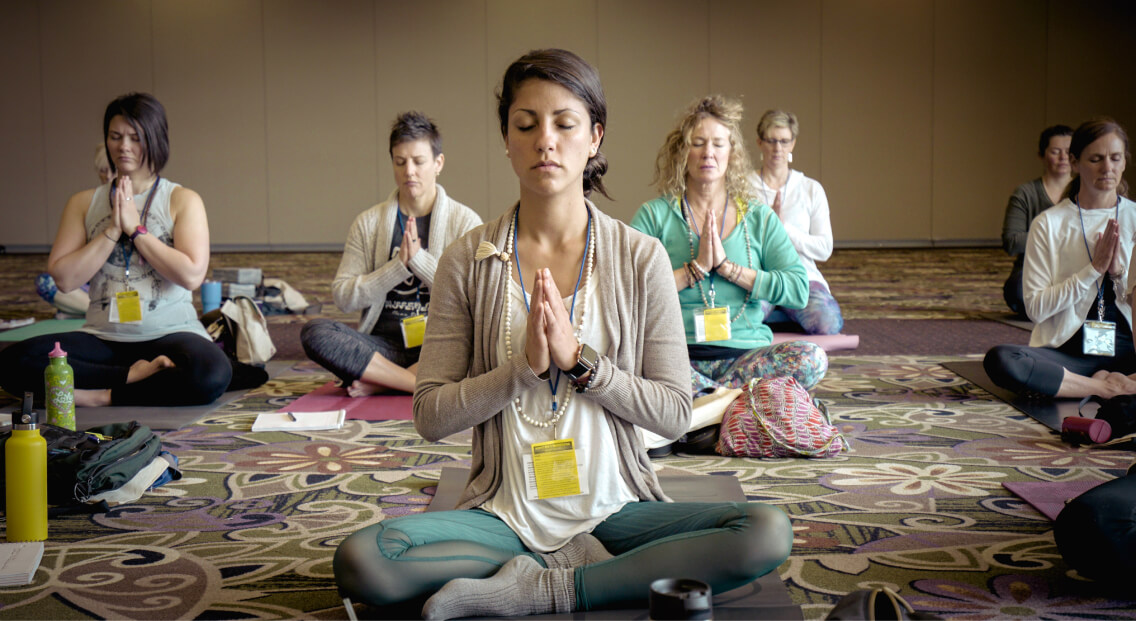High blood pressure, or hypertension, affects millions in the United States. It’s vital to manage it for good health. Yoga can help regulate blood pressure, but knowing which poses to avoid is key. Some poses can raise blood pressure, which is bad for those with hypertension.
Understanding the link between yoga and high blood pressure is crucial. Knowing which poses can worsen hypertension helps practice yoga safely. It’s important to focus on blood pressure regulation and manage hypertension through yoga and lifestyle changes.
Before you read this blog just note that scienceandyoga has not done any tests but we have analyzed many reports from Harvard, NIH etc and simplified those findings for you.

Introduction to Yoga and Hypertension
Yoga can help manage hypertension, but it must be done carefully. Knowing which poses to avoid and how to practice safely is important. This means choosing gentle, low-impact poses and avoiding those that can raise blood pressure.
Key Takeaways
- Certain yoga poses can increase blood pressure and should be avoided by individuals with hypertension.
- Hypertension management through yoga requires a careful and informed approach.
- Blood pressure regulation is crucial for individuals with high blood pressure.
- Yoga can be a valuable tool in managing hypertension when practiced safely and effectively.
- Gentle, low-impact yoga poses are recommended for individuals with high blood pressure.
- It’s essential to be mindful of the connection between yoga and high blood pressure when practicing yoga.
Understanding the Connection Between Yoga and High Blood Pressure
Yoga and blood pressure are closely linked. Regular yoga practice can greatly benefit your heart health. It can help manage high blood pressure and improve your overall well-being.
Yoga reduces stress and anxiety, boosts circulation, and increases oxygen in the body. These effects come from yoga poses, breathing techniques, and meditation. They help relax and balance the body, making yoga a great tool for heart health.
How Yoga Impacts Blood Pressure
Yoga lowers blood pressure by reducing stress and promoting relaxation. Stress triggers our body’s “fight or flight” response, raising blood pressure. Yoga counters this by activating the parasympathetic nervous system, which relaxes and lowers blood pressure.
Yoga also improves blood flow and reduces inflammation. These factors contribute to lower blood pressure.
Benefits of Regular Yoga Practice
Regular yoga practice offers many benefits for heart health. It can lower blood pressure, improve circulation, and boost overall well-being. Key benefits include:
- Reduced blood pressure
- Improved circulation
- Increased oxygenation of the body
- Reduced stress and anxiety
- Improved overall well-being
The Science Behind Yoga’s Impact on Cardiovascular Health
The science behind yoga’s heart health benefits is clear. Yoga reduces inflammation, improves blood flow, and promotes relaxation. These effects contribute to lower blood pressure and better heart health. By adding yoga to your daily routine, you can enjoy these benefits and improve your overall well-being.
Essential Safety Precautions Before Starting Yoga
Practicing yoga, especially with high blood pressure, requires careful steps. As a beginner, it’s key to be cautious and aware. Always talk to a doctor before starting yoga, especially if you have health issues. This ensures you practice safely.
Choosing the right yoga style is crucial. Gentle or restorative yoga might be better for those with high blood pressure and yoga. Start with yoga for beginners classes or workshops for a gentle introduction.
Listen to your body during practice. Stop if you feel pain, discomfort, or dizziness. Stay hydrated and practice on an empty stomach. These steps help make yoga safe and enjoyable, even with high blood pressure.
Yoga is a journey that needs patience, awareness, and caution. By doing so, you can enjoy yoga’s benefits like reduced stress, better flexibility, and a stronger body and mind connection.
Dangerous Yoga Poses for Hypertension Patients
For those with high blood pressure, yoga safety is key. Certain poses can make their condition worse. It’s important to know which yoga poses to avoid to stay safe and get the most out of yoga.
Some yoga poses are not good for people with high blood pressure. Inverted poses can raise blood pressure too much. Hot yoga, done in a heated room, can also be risky because it can cause dehydration and raise blood pressure.
To safely practice yoga with high blood pressure, it’s important to know the risks. Avoid certain poses, drink plenty of water, and listen to your body. By being careful and aware, people with high blood pressure can enjoy yoga’s benefits without the risks.
- Inverted poses, such as headstands and handstands, can increase blood pressure and should be avoided.
- Hot yoga and high-intensity poses can also be problematic and should be approached with caution.
- It’s essential to listen to your body and modify or avoid poses that cause discomfort or pain.
Knowing the risks and taking precautions can help people with high blood pressure practice yoga safely. This can lower their risk of complications and improve their health and well-being.
The Best Yoga for High Blood Pressure: Safe and Effective Poses
Yoga can be a great help in managing high blood pressure. Certain safe yoga poses can help control blood pressure, lower stress, and boost heart health. If you have high blood pressure, it’s key to do yoga for high blood pressure with a trained teacher.
Some top safe yoga poses for high blood pressure are:
- Gentle stretches to improve flexibility and reduce tension
- Breathing exercises to calm the mind and regulate blood pressure
- Relaxation techniques to reduce stress and promote overall well-being
Adding these safe yoga poses to your daily routine can help manage high blood pressure and enhance your health. Always talk to your doctor before starting any new exercise, like yoga for high blood pressure.
Breathing Techniques to Regulate Blood Pressure
Using breathing techniques to control blood pressure is very helpful. Techniques like pranayama calm the mind and body. This reduces stress and anxiety, which can lead to high blood pressure. Adding these techniques to your daily life can help manage your blood pressure and improve your health.
Yoga breathing exercises, such as pranayama, slow down your heart rate and lower blood pressure. These exercises slow your breathing, calming your nervous system. Regular practice can lower your blood pressure and boost your health.
To start with breathing techniques for blood pressure, learn the basics of pranayama. This means mastering slow, deep breathing. Practicing these methods calms your mind and body, reducing stress and anxiety that can cause high blood pressure.
Key Benefits of Breathing Techniques
- Reduced stress and anxiety
- Lower blood pressure
- Improved overall health
By adding breathing techniques like pranayama and yoga breathing to your daily routine, you can better manage your blood pressure. This can also improve your overall health.
Modifications for Common Yoga Poses
When starting yoga, it’s key to think about making poses easier. This is especially true for those with high blood pressure. Some poses can be tough, but with the right tweaks, anyone can benefit from yoga. For instance, downward-facing dog can be made easier by bending the knees or using a block.
Poses like forward bends, backbends, and twists might need changes for those with high blood pressure. Here are some tips to modify these poses:
- Use props like blocks, straps, or blankets to support your body and ease strain
- Bend the knees or elbows to lessen pressure on your joints
- Shorten the time in the pose or take breaks to rest and relax
By making these adjustments, you can lower injury risks and enjoy yoga’s benefits. These include less stress and better health. Always listen to your body and talk to a doctor or yoga teacher if you have concerns about yoga with high blood pressure.
With the right approach and tweaks, yoga can greatly improve your health, even with high blood pressure. Being aware of your body and adjusting poses as needed leads to a safe and rewarding yoga practice. You’ll gain flexibility, strength, and relaxation.
Creating a Safe Yoga Routine for Hypertension
Creating a yoga routine for high blood pressure is key. It’s important to know your limits and adjust poses as needed. The time and how often you practice yoga also matter.
A good yoga schedule can help control blood pressure and boost health. Here are some tips for a yoga routine for high blood pressure:
- Morning practice: Start with gentle stretches and breathing exercises to help regulate blood pressure and energize the body.
- Evening practice: Focus on relaxing poses and calming breathing techniques to help reduce stress and promote a restful night’s sleep.
- Weekly schedule: Aim to practice yoga at least 3-4 times a week, allowing for rest days in between to avoid overexertion.
By following these tips, you can enjoy the benefits of yoga safely. Always listen to your body and take breaks when needed. This way, yoga can be a fun and safe part of your life.
Regular and safe yoga practice can help manage high blood pressure. A structured yoga schedule and safe practices can lower risks and improve health. This leads to a better quality of life.
Warning Signs to Watch For During Practice
When you practice yoga, especially with high blood pressure, it’s key to know certain yoga warning signs. These signs show when you might need to stop or change your practice. They help keep your yoga safety and health in check.
Some common warning signs to watch for during yoga practice include:
- Dizziness or lightheadedness
- Nausea or vomiting
- Chest pain or discomfort
- Shortness of breath
If you feel any of these symptoms, stop right away and rest. It’s also important to talk to your healthcare provider or a qualified yoga instructor. They can help you safely adjust your practice and manage high blood pressure and yoga.
How to Talk to Your Yoga Instructor About Blood Pressure
When you practice yoga, it’s key to talk openly with your instructor. This is especially true if you have high blood pressure and yoga. Some poses can make your condition worse. So, it’s important to share your health concerns before starting.
Talking about your health lets your instructor give you the right advice. They can suggest changes to make your practice safer. This way, you both can make sure your yoga is safe and helps with high blood pressure and yoga.
When you talk to your instructor, mention your medical history and any symptoms. Also, share any worries you have about certain poses. By focusing on yoga safety and keeping the lines of communication open, you can enjoy yoga’s benefits. And you’ll avoid risks linked to high blood pressure and yoga.
- Be honest about your health conditions and concerns
- Ask about modifications for specific poses
- Discuss your goals and what you hope to achieve through yoga
By teaming up with your instructor and focusing on yoga safety, you can make a practice that’s good for you. It will help you manage high blood pressure and yoga well.
Combining Yoga with Other Blood Pressure Management Strategies
Managing blood pressure is best done with a full plan. This is where yoga and lifestyle changes shine. Adding yoga to your day can lower hypertension and boost your health.
Here are some ways to mix yoga with other blood pressure management strategies:
- Creating a balanced diet that supports heart health
- Engaging in regular physical activity, such as walking or swimming
- Practicing stress-reducing techniques, like meditation or deep breathing
By making these changes and adding yoga to your routine, you can fight hypertension head-on. Always talk to your doctor before starting any new exercise or treatment.

